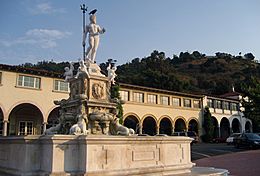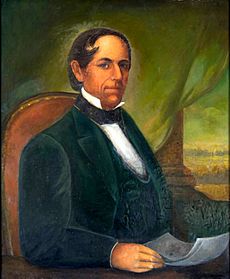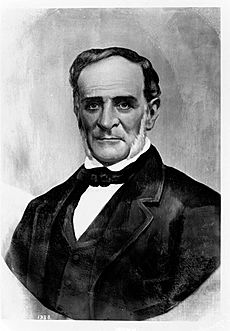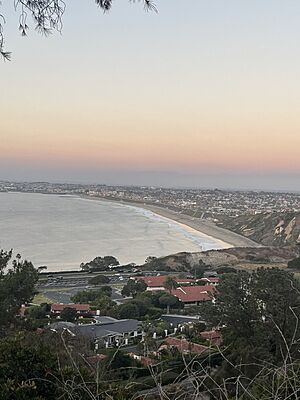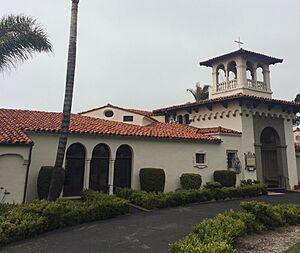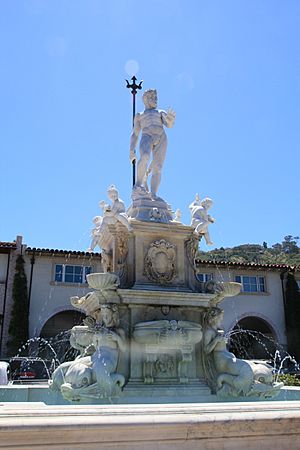Palos Verdes Estates, California facts for kids
Quick facts for kids
Palos Verdes Estates, California
|
||
|---|---|---|
|
Clockwise: Malaga Cove Plaza; Plaza archway; Malaga Cove Library
|
||
|
||
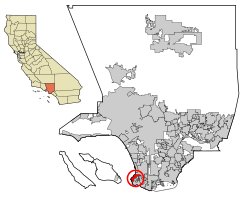
Location of Palos Verdes Estates in Los Angeles County, California
|
||
| Country | ||
| State | ||
| County | Los Angeles | |
| Incorporated | December 20, 1939 | |
| Government | ||
| • Type | Council–manager | |
| Area | ||
| • Total | 4.77 sq mi (12.36 km2) | |
| • Land | 4.77 sq mi (12.36 km2) | |
| • Water | 0.00 sq mi (0.00 km2) 0.01% | |
| Elevation | 210 ft (64 m) | |
| Population
(2020)
|
||
| • Total | 13,347 | |
| • Density | 2,798.1/sq mi (1,079.9/km2) | |
| Time zone | UTC−08:00 (PST) | |
| • Summer (DST) | UTC−07:00 (PDT) | |
| ZIP Code |
90274
|
|
| Area codes | 310/424 | |
| FIPS code | 06-55380 | |
| GNIS feature IDs | 1652770, 2411363 | |
Palos Verdes Estates is a beautiful coastal city in Los Angeles County, California. It is located on the Palos Verdes Peninsula, right next to the Pacific Ocean. The city was carefully designed by a famous landscape architect named Frederick Law Olmsted Jr..
In 2020, about 13,347 people lived here. Palos Verdes Estates is known for being one of the wealthiest cities in the United States. It also has excellent schools, fun hiking trails, and amazing homes right by the ocean.
Contents
History of Palos Verdes Estates
Palos Verdes Estates was created as a special "planned community" in 1923. This means it was designed from the start, not just built randomly. A large piece of land, about 3,200 acres, was set aside from a bigger property called Rancho Palos Verdes.
A man named Frank A. Vanderlip helped buy this land. He wanted to create a unique community. In 1923, special rules were made for the land. These rules said that half of the land had to be used for public spaces like roads and parks. They also planned for horse riding paths, a golf course, and kept several miles of the coastline free from buildings. Most of the remaining land was meant for single-family homes.
Planning and Early Rules
The designers, Frederick Law Olmsted Jr. and Charles Cheney, used "deed restrictions" to control how the area would look. These were rules attached to the land itself. They stopped noisy businesses, bars, and cemeteries from being built.
Sadly, these rules also included unfair practices. For example, they made it hard for people of certain races to buy or rent homes. African Americans were generally not allowed on properties, except for workers like gardeners or housekeepers. These unfair rules were called "sundown rules" because some people were expected to leave by sundown.
These types of rules were declared illegal in 1948. It took even longer, until 1968, with the Fair Housing Act, for everyone to truly have equal housing rights.
An "art jury" also reviewed all building plans. They checked everything from the style and materials to the color of houses and even the angle of roofs. Even fences and hedges needed their approval!
First Buildings and Incorporation
The oldest building in the city is La Venta Inn, built in 1923. It was first used as an office to sell land. Other early buildings were built around the Malaga Cove shopping area.
Palos Verdes Estates officially became a city in 1939. The Malaga Cove Plaza building and the Palos Verdes Public Library were designed by architect Myron Hunt. These buildings are now listed on the National Register of Historic Places. In the center of Malaga Cove Plaza, you can see a replica of the famous Neptune fountain from Bologna, Italy.
Geography of Palos Verdes Estates
Palos Verdes Estates covers about 4.8 square miles (12.36 square kilometers) of land. It is bordered by the city of Torrance to the north and east. To the south, it borders Rancho Palos Verdes, and to the southeast, Rolling Hills Estates.
Population and People
In 2020, the city's population was 13,347 people. Most people in Palos Verdes Estates live in family homes. The city is known for its diverse community, with people from many different backgrounds living and working together.
Education in Palos Verdes Estates
Palos Verdes Estates has excellent schools that are part of the Palos Verdes Peninsula Unified School District.
Public Schools
The area is home to two highly-rated high schools:
- Palos Verdes Peninsula High School (the "Panthers") is known for its strong academics. It often has many students recognized as National Merit Scholars. Its science and computer science programs are very advanced. Students even compete in national robotics challenges!
- Palos Verdes High School (the "Sea Kings") also has high academic scores. Its students have also competed in advanced robotics challenges, even against universities!
Private Schools
Chadwick School is a well-known private school in the area. It serves students from kindergarten all the way through 12th grade and was founded in 1935.
Public Libraries
The Palos Verdes Library District runs the Malaga Cove Library, which is located right in Palos Verdes Estates. It's a great place to find books and learn!
Notable People from Palos Verdes Estates
Many interesting people have lived in or are from Palos Verdes Estates:
- Matt Barnes (born 1980) – A professional basketball player.
- Chester Bennington (1976–2017) – The lead singer of the band Linkin Park.
- David Benoit (born 1953) – A talented musician.
- Robert DeLeo (born 1966) – The bassist and co-founder of the band Stone Temple Pilots.
- Bill Laimbeer (born 1957) – A famous American basketball player.
- Daniel Levitin (born 1957) – A best-selling author, neuroscientist, and musician.
- Matt Manfredi (born 1971) – An American screenwriter.
- Randy Nauert (1945-2019) – A bassist and co-founder of The Challengers band.
- Donald Peterman (1932–2011) – An Academy Award-nominated cinematographer.
- Christen Press (born 1988) – An American soccer forward and World Cup champion.
- Shahbudin Rahimtoola (1931–2018) – A well-known cardiologist.
- Anderson Silva (born 1975) – A UFC Middleweight Champion.
- Gary Wright (1943-2023) – A musician.
See also
 In Spanish: Palos Verdes Estates para niños
In Spanish: Palos Verdes Estates para niños


